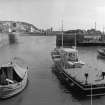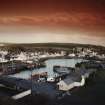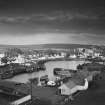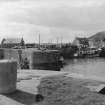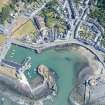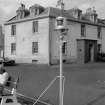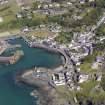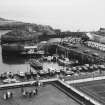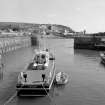Portpatrick Harbour, Inner Harbour
Harbour (19th Century)
Site Name Portpatrick Harbour, Inner Harbour
Classification Harbour (19th Century)
Alternative Name(s) New Harbour
Canmore ID 241331
Site Number NW95SE 9.02
NGR NW 99802 54194
NGR Description Centred NW 99802 54194
Datum OSGB36 - NGR
Permalink http://canmore.org.uk/site/241331
- Council Dumfries And Galloway
- Parish Portpatrick
- Former Region Dumfries And Galloway
- Former District Wigtown
- Former County Wigtownshire
NW95SE 9.02 centred 99802 54194
Publication Account (1986)
In the days of sail, Portpatrick was the usual Scottish terminal on the short sea-crossing between Galloway and Ulster. Such journeys had probably been made since time immemorial, but it was largely through the efforts of a cross-channel landlord in the first half of the 17th century that Portpatrick and its Irish counterpart, Donaghadee, were able to convert their geographical advantages into exclusive privileges. Hugh Montgomery, lord of Ards, and from 1608 until his death in 1636, laird of Dunskey (including what was then known as Port Montgomery), acquired in 1616 a royal warrant restricting travel between Galloway and Ards to these two ports, making this a major route to the Scottish plantation of Ulster.Portpatrick was the main port of entry for imported Irish cattle, and from 1662 to 1848 was the principal station for the Irish ferry and packet-service. Upon the completion of the military road in 1765, it served as a transit-station for troops, a function commemorated by such names as Barrack Street and Colonel Street, and from 1790 was the terminus of a daily mail-coach service. Just as Gretna did for the English at the other end of this road, so Portpatrick enabled fugitive Irish couples to contract hurried marriages in accordance with Scottish procedures.
The early use of the landing-places here was assisted by few engineered works, and has left no obvious trace. Even the 'footprint' stone from which St Patrick made his mighty legendary stride across the North Channel was obliterated in the course of 19th century harbour-works. A traveller in 1636 complained that it was a 'most craggy, fIlthy passage, . . . very dangerous for horses to go in and out ... ; and when any horses land here, they are thrown into the sea, and swim out'. In 1768 John Smeaton concluded that, except for a passenger landing-platform, the harbour was 'almost in a state of nature'. Because of the rocky inlet's natural limitations as a safe, sheltered and spacious anchorage, Portpatrick's potential as a major packet-station continually excited sharp differences of opinion, a point which rivals were never slow to pursue in their promotion of the claims of Port Logan, and subsequently Stranraer.
The harbour-works completed in 1778 in accordance with Smeaton's plan were the first in a century-long campaign to convert these limited facilities into a reliable major harbour. Smeaton's scheme to protect the rebuilt inner or northern harbour (which then lay around the rocky islet known as McCook's Craig) was nullified by the inadequacy of its northern pier and bulwark, twice rebuilt before their final destruction in 1801. This left only a south harbour with a lighthouse and a short pier which William Daniell illustrated in 1816, and of which a fragmentary stump still survives just north of the present late 19th century lighthouse. This was the position when Telford made his unfavourable report in 1802, and these were some of the problems to which John Rennie addressed himself in 1814-18.
Rennie's plan was essentially a scaled-up version of Smeaton's scheme, involving much more massive and expensive piers. Work began in 1820; the south pier was completed in 1832, and the lighthouse at the pierhead in 1836. However, when this new pier was seriously breached by a hurricane in 1839, the north pier was left unfinished, as it remains to this day. Despite all these setbacks, a boat dock was built in 1865 to accommodate large mail-steamers and to connect with the railway. But Portpatrick's fate had already been sealed by the ability of steamboats, introduced by the Post Office in 1825, to make use of the sheltered waters of Loch Ryan. By the 1860s the Irish mails were being handled through Stranraer and Larne, and in 1868 the ferry service was officially transferred to that route. So far as Portpatrick was concerned, the final act of this epic struggle was the dismantling of the lighthouse at the south pier-head in 1871, and then, in 1873, the official abandonment of the outer harbour to the mercies of an unrelenting sea.
Information from ‘Exploring Scotland’s Heritage: Dumfries and Galloway’, (1986).
















